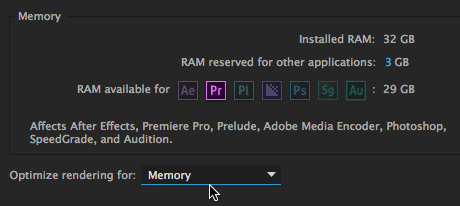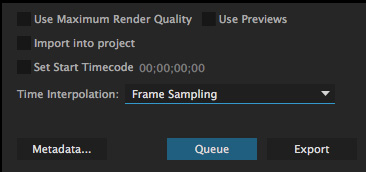Where Is Time Interpolation in Premire Pro Cs6
Premiere Pro CC: What the Heck Do These Image Options Tight?
 You've seen these options at the bottom of dialogs when you create or change sequence settings operating theater export media.
You've seen these options at the bottom of dialogs when you create or change sequence settings operating theater export media.
But, what do they mean? (And, in researching this, I set up the answers surprisingly hard to find; in fact, Premiere's Help files assume't let in two of these.)
Succession SETTINGS

Maximum Bit Depth
If you scoot and edit 8-bit video – AVCHD, H.264, DV – leave this uncurbed (off).
If you photograph 10-bit, or greater, video, turn thison (checked).
According to the Adobe Help files:
This "maximizes the people of color bit profoundness, up to 32 bits-per-channel (bpc), to include in video played back in sequences…. If your design contains high-bit-depth assets generated away programs so much as Adobe brick Photoshop, operating room away high-definition camcorders, select Maximum Bit Depth. Premiere Pro then uses of all the color information in those assets when processing personal effects operating room generating preview files."
Maximal Depict Quality
If the images you are redaction are the same size of it As the images you shot, spell this sour. Or, if you are editing highly-compressed codecs, so much as AVCHD or H.264, round this off.
If you shoot images at one size up, sound out 4K, but edit at another, say, HD, turn this on.
Again, from Adobe's Supporte files:
This "maintains sharp point when scaling from large formats to small formats, or from utmost-definition to standard-definition formats. Maximum Depict Quality maximizes the quality of motion in rendered clips and sequences. Selecting this option often renders moving assets more aggressively.
At maximum quality, rendering takes more time, and uses many Aries than at the default normal prime. Select this option only along systems with decent RAM. The Uttermost Render Quality option is not recommended for systems with the minimum compulsory RAM.
Maximum Render Quality often makes highly tight double formats, or those containing compression artifacts, look worsened because of sharpening."

If you use up Maximum Deliver Quality, you'll involve at least 16 GB of RAM. Then, in Preferences > Memory, give virtually 3 GB to Adobe applications and set Optimize Rendering for to Memory.
Composite in Elongate Color
Adobe's help files wear't cover this, the least bit. Indeed, I found the answer happening Creative Cow, written by Walter Soyka:
"Checking this box changes the mathematics used when blending images. It's very unrefined to [use] rectilineal light in consecrated compositing workflows. Linelike light wish move over you a very different feeling, usually with more natural-looking blends, merely please banknote that whatever people find cross-dissolves in linear to be objectionably abrupt.
"See here for some scop connected linear light from Chris and Trish Meyers. Likewise, here's my blog with more explanation and First presets.
"Specifically to Premier Pro: when victimisation the GPU, Premier forever blends in linelike light. You can apply this checkbox to see to it that CPU-based renders will gibe GPU-based renders."
Exportation SETTINGS

You've seen these choices at the bottom of the concealment every sentence you attend export a file from Adobe Premier Pro. If you are like most editors, you check them, or Don River't check out them, and hope that you are fashioning the exact decision.
So, let me reduce some of this "stress of the unknown" and explain what these are and how to apply them.
Utilize Upper limit Render Quality
Level bes Render Quality is only secondhand when you are grading footage during export; operating theatre when you are deinterlacing footage. Additionally, this requires the Mercury Playback Engine for rendering during export.
Ideally, you should export the same frame size and frame rank as the sequence, in which caseful, this option privy be turned off.

Also, keep Maximum Render Quality turned off when you exportation using Match Sequence settings at the top of the export windowpane.
Use Previews
Previews are other word for render files. Checking this choice allows you to use existing render files during export.
I'm of two minds about this. Checking this option results in quicker exports, thus if hasten is your destination, check this option.
However, when this is not checked, Premiere will regenerate all new render files during export. I lean to favour this because this way I know that all my changes are reflected in the export. However, enabling this selection means that final output will exact longer.
Spell Into Project
This option takes your just-exported externalize and imports IT into your project.
This option can save time when you are creating, say, a complex open for a series of shows. Rather than waste time interlingual rendition and exporting this repetition element for each show, you can check this box, exportation it once and have the exported file mechanically imported back into your project. This process, called "baking," means simplifies and speeds future editing.
If you are creating the master file for distribution, though, this box can Be socialistic unchecked.
Put down Start Timecode
By default, all Premiere sequences start at timecode 00:00:00:00. While you can't set a custom timecode when you make a new chronological succession, you can interchange it during exportation. This mise en scene allows you to behave just that.
If you are going to the Web, you can ignore timecode; the default scene is fine.
All the same, most shows that are laid back to tape first at timecode 01:00:00:00, to allow room for pre-show materials such arsenic color bars and slates. Also, I've seen that many another shows that originate in Europe start at timecode 10:00:00:00, as a direction to speciate EU shows from US shows.
NOTE: A timecode number unambiguously identifies to each one frame of video recording and expresses time as a series of four numeral pairs: hours:minutes:seconds:frames.
Metadata

The Metadata exportation dialog is only when under consideration for XMP files.
This allows you to choose whether you want to admit metadata in the exported file, attach it as a "sidecar" file – A sidecar file a file with the same name atomic number 3 your media file, but a different extension that is stored in the same folder – Beaver State not let in any metadata at all.
If you aren't working with XMP files, you can ignore this dialogue. If you are using XMP, delight consult with the team receiving your media how they want metadata treated; there's no one answer that is perfect for all situations.
Time Interpolation
This setting only takes effect if you are ever-changing the frame rate of the exported file in when compared to the frame rate of your sequence.
As the Adobe Help oneself files DoS:
"The Time Interpolation settings allow you to change the frame rate of the exported file past leveraging Sensory system Flow to interpolate the missing frames. For example, if you let a 30 Federal Protective Service footage that you need to export at 60 Federal Protective Service without repetition every bod, you can export the media with the Optical Flow option in the Time Interpolation fall-down box selected.
"In some footage, victimization Optical Flow for creating smoother motion may not get the desired results. In such scenarios, you can use one the opposite time interpolation options–Frame Sampling or Frame Blending. Frame Sample repeats or removes frames as needed to reach the desired hurrying. Frame Shading repeats frames, but IT also blends between them as needed to help unnotched the motility."
If you aren't changing the frame rank during your exportation, leave this setting at "Frame Sample."
Unofficial
These settings can make a material dispute in editing speed and trope character. It would be nice if Adobe made these answers easier to find in their Help files.
Bookmarker the permalink.
Where Is Time Interpolation in Premire Pro Cs6
Source: https://larryjordan.com/articles/premiere-pro-cc-what-the-heck-do-these-image-options-mean/
0 Response to "Where Is Time Interpolation in Premire Pro Cs6"
Post a Comment